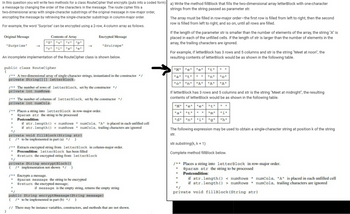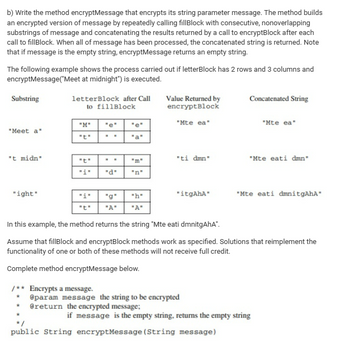
Database System Concepts
7th Edition
ISBN: 9780078022159
Author: Abraham Silberschatz Professor, Henry F. Korth, S. Sudarshan
Publisher: McGraw-Hill Education
expand_more
expand_more
format_list_bulleted
Question
Please solve part a and b.

Transcribed Image Text:In this question you will write two methods for a class RouteCipher that encrypts (puts into a coded form) a) Write the method fillBlock that fills the two-dimensional array letterBlock with one-character
a message by changing the order of the characters in the message. The route cipher fills a
strings from the string passed as parameter str.
two-dimensional array with single-character substrings of the original message in row-major order,
encrypting the message by retrieving the single-character substrings in column-major order.
For example, the word "Surprise" can be encrypted using a 2-row, 4-column array as follows.
Original Message
*Surprise"
Contents of Array
"Sur "p"
"ris" "e"
Encrypted Message
*Sruirspe*
An incomplete implementation of the RouteCipher class is shown below.
public class RouteCipher
/** A two-dimensional array of single-character strings, instantiated in the constructor */
private String ( ) ( ) letterBlock;
/** The number of rows of letterBlock, set by the constructor */
private int numRows;
/** The number of columns of letterBlock, set by the constructor */
private int numCols;
/** Places a string into letterBlock in row-major order.
@param str the string to be processed
Postcondition:
if str.length() < numRows
if str.length() > numRows
numCols, "A" is placed in each unfilled cell
numCols, trailing characters are ignored
private void fillBlock(String str)
{ /* to be implemented in part (a) */ }
/Extracts encrypted string from letterBlock in column-major order.
Precondition: letterBlock has been filled
* @return the encrypted string from letterBlock
private String encryptBlock()
{/implementation not shown */ }
/** Encrypts a message.
* @param message the string to be encrypted
@return the encrypted message;
if message is the empty string, returns the empty string
public String encryptMessage(String message)
{ /* to be implemented in part (b) */ }
// There may be instance variables, constructors, and methods that are not shown.
The array must be filled in row-major order-the first row is filled from left to right, then the second
row is filled from left to right, and so on, until all rows are filled.
If the length of the parameter str is smaller than the number of elements of the array, the string "A" is
placed in each of the unfilled cells. If the length of str is larger than the number of elements in the
array, the trailing characters are ignored.
For example, if letterBlock has 3 rows and 5 columns and str is the string "Meet at noon", the
resulting contents of letterBlock would be as shown in the following table.
"M" "e" "e" | "t"
"a" "t"
"n"
"o" "n" "A" "A" "A"
If letterBlock has 3 rows and 5 columns and str is the string "Meet at midnight", the resulting
contents of letterBlock would be as shown in the following table.
"M" "e" "e" "t"
"a" "t"
"d" "n" i "g" "h"
The following expression may be used to obtain a single-character string at position k of the string
str.
str.substring(k, k+1)
Complete method fill Block below.
/** Places a string into letterBlock in row-major order.
@param str the string to be processed
Postcondition:
if str.length() < numRows * numCols, "A" is placed in each unfilled cell
if str.length() > numRows numCols, trailing characters are ignored
private void fillBlock (String str)
}

Transcribed Image Text:b) Write the method encryptMessage that encrypts its string parameter message. The method builds
an encrypted version of message by repeatedly calling fillBlock with consecutive, nonoverlapping
substrings of message and concatenating the results returned by a call to encryptBlock after each
call to fill Block. When all of message has been processed, the concatenated string is returned. Note
that if message is the empty string, encryptMessage returns an empty string.
The following example shows the process carried out if letterBlock has 2 rows and 3 columns and
encryptMessage("Meet at midnight") is executed.
Substring
letterBlock after Call
to fillBlock
Value Returned by
encryptBlock
Concatenated String
"M"
"e"
"Mte ea"
"Mte ea"
"Meet a"
"t"
"t midn"
"t"
"m"
"ti dmn"
"Mte eati dmn"
"1"
"d"
"n"
"ight"
"g"
"h"
"itgAhA"
"Mte eati dmnitgAhA"
"A"
"A"
In this example, the method returns the string "Mte eati dmnitgAhA".
Assume that fillBlock and encryptBlock methods work as specified. Solutions that reimplement the
functionality of one or both of these methods will not receive full credit.
Complete method encryptMessage below.
/Encrypts a message.
@param message the string to be encrypted
@return the encrypted message;
if message is the empty string, returns the empty string
public String encryptMessage(String message)
SAVE
AI-Generated Solution
info
AI-generated content may present inaccurate or offensive content that does not represent bartleby’s views.
Unlock instant AI solutions
Tap the button
to generate a solution
to generate a solution
Click the button to generate
a solution
a solution
Knowledge Booster
Similar questions
- Use python to solve.arrow_forwardThe correct statements are: If A is polynomially reducible to B and B and C are both in NP, then AU C is in NP. If A is polynomially reducible to B and B and C are both in P, then AU C is in P. If A is polynomially reducible to B, B is polynomially reducible to C and C is in P, then AUC is in P. If A is polynomially reducible to B, B is polynomially reducible to C and C is in NP, then AUC is in NP.arrow_forwardGiven that x and y are integers such that 0 < x < y < 9 and that the integer 77265x597y is divisible by 12, find x and y.arrow_forward
- Can you solve for x and type the correct code? Please remember to type in ALL CAPS with no spaces.arrow_forward1. solve a system of ordinary differential equations of first order numerically using solve_ivp. 2. generate plots after "solving" the differential equations using matplotlib.pyplot. In that tutorial, the equations of motion described the dynamics of a simple pendulum. In this problem, you will investigate the motion of a satellite orbiting the Earth. This is modelled as a two-body dynamics system. A brief outline of what you need to do in this problem set is below and that is followed by a systematic set of questions towards achieving specific objectives. You will find the tutorial a handty reference here. In this problem, you will have to first create a Python function called twobody_dynamics_first_order_EOMS. Given a time t and a state vector X, this function will return the derivatives of the state vector. Mathematically, this means you are computing X using some dynamics equation X = f(t, X). Once you have this function in Python, you can solve the differential equations it…arrow_forwardProblem 3: Use one of the proof methods to prove the following results. 1. Use a proof by cases to show that min(a, min(b, c)) = min(min(a, b), c) whenever a, b, and c are real numbers. 2. Show that if a, b, and c are real numbers and a = 0, then there is a unique solution of the equation ax + b = c.arrow_forward
- Can you please solve a and b. The exercise is for a course call computer organizationarrow_forwardAnswer: 1.792e3 secondsarrow_forward3. The velocity of a particle which starts from rest is given by the following table. t see) 0 2 8 10 12 14 16 v (fusee) o 12| 16 26 40| 44 25 12 18 Evaluate using trapezium rule, the total distance travelled in 18 seconds.arrow_forward
- 6. Which of the following options are correct with reference to P-complete problems?a) used for the problems which are difficult to solve in limited spaceb) every problem in P can be reduced to it using proper reductionsc) complete problem for complexity class Pd) all of the mentionedarrow_forwardHW3_3 Using built-in functions a) Use the built-in function roots to find all the roots of the polynomial g(x) = x¹+65x³ + 86x + 128. Print your results. b) Given f(x) = x³ – 5x + 10 and g(x) = 4 sin(3x) + 6 Graph these two functions (using different colors for the lines) such that all intersection points are shown. Solve for the intersection points and plot them on the graph with red stars. Use the built-in function brentq. Note: Import appropriate libraries.arrow_forwardPlease help! with explanationarrow_forward
arrow_back_ios
SEE MORE QUESTIONS
arrow_forward_ios
Recommended textbooks for you
 Database System ConceptsComputer ScienceISBN:9780078022159Author:Abraham Silberschatz Professor, Henry F. Korth, S. SudarshanPublisher:McGraw-Hill Education
Database System ConceptsComputer ScienceISBN:9780078022159Author:Abraham Silberschatz Professor, Henry F. Korth, S. SudarshanPublisher:McGraw-Hill Education Starting Out with Python (4th Edition)Computer ScienceISBN:9780134444321Author:Tony GaddisPublisher:PEARSON
Starting Out with Python (4th Edition)Computer ScienceISBN:9780134444321Author:Tony GaddisPublisher:PEARSON Digital Fundamentals (11th Edition)Computer ScienceISBN:9780132737968Author:Thomas L. FloydPublisher:PEARSON
Digital Fundamentals (11th Edition)Computer ScienceISBN:9780132737968Author:Thomas L. FloydPublisher:PEARSON C How to Program (8th Edition)Computer ScienceISBN:9780133976892Author:Paul J. Deitel, Harvey DeitelPublisher:PEARSON
C How to Program (8th Edition)Computer ScienceISBN:9780133976892Author:Paul J. Deitel, Harvey DeitelPublisher:PEARSON Database Systems: Design, Implementation, & Manag...Computer ScienceISBN:9781337627900Author:Carlos Coronel, Steven MorrisPublisher:Cengage Learning
Database Systems: Design, Implementation, & Manag...Computer ScienceISBN:9781337627900Author:Carlos Coronel, Steven MorrisPublisher:Cengage Learning Programmable Logic ControllersComputer ScienceISBN:9780073373843Author:Frank D. PetruzellaPublisher:McGraw-Hill Education
Programmable Logic ControllersComputer ScienceISBN:9780073373843Author:Frank D. PetruzellaPublisher:McGraw-Hill Education

Database System Concepts
Computer Science
ISBN:9780078022159
Author:Abraham Silberschatz Professor, Henry F. Korth, S. Sudarshan
Publisher:McGraw-Hill Education

Starting Out with Python (4th Edition)
Computer Science
ISBN:9780134444321
Author:Tony Gaddis
Publisher:PEARSON

Digital Fundamentals (11th Edition)
Computer Science
ISBN:9780132737968
Author:Thomas L. Floyd
Publisher:PEARSON

C How to Program (8th Edition)
Computer Science
ISBN:9780133976892
Author:Paul J. Deitel, Harvey Deitel
Publisher:PEARSON

Database Systems: Design, Implementation, & Manag...
Computer Science
ISBN:9781337627900
Author:Carlos Coronel, Steven Morris
Publisher:Cengage Learning

Programmable Logic Controllers
Computer Science
ISBN:9780073373843
Author:Frank D. Petruzella
Publisher:McGraw-Hill Education